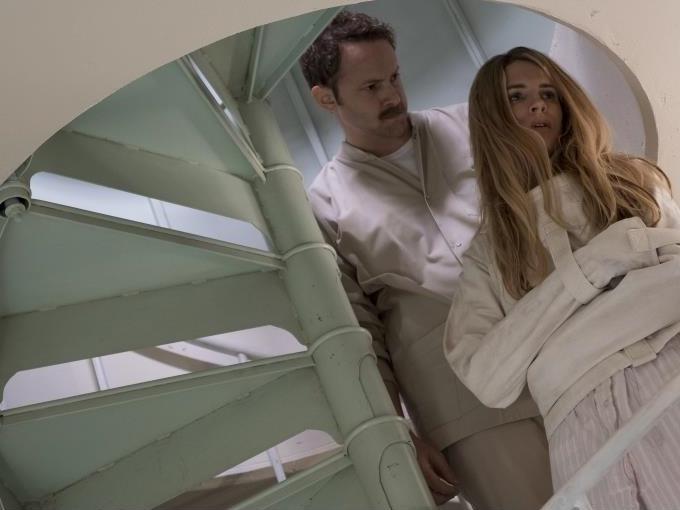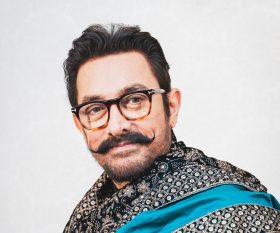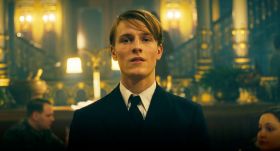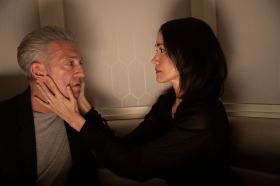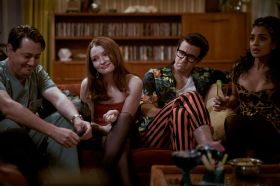Visions and dreams abound in The OA: Part II. Photo credit: Nicola Goode, Netflix.
The entire second season of The OA – that stands, more or less, for “original angel” – was released on Netflix in one 8-episode lump for faithful binge-watchers on 22 March 2019. I took the plunge. The first season from December 2016 had intrigued me, with its dizzy succession of reality switches, mysterious flashbacks, and glimpses of alternative destinies. The cliffhanger ending of that season teased its fans not only with the enigmatic news that the dying OA herself, Prairie (Brit Marling), was on her way to “another dimension”, but also with the canny philosophical advice that any vision of the future must necessarily be “dark”, not because it’s bleak, but because it’s … as yet unwritten.
But the second season, as it turns out, is not really about the “unwritten future” at all; it begins by winding back (by “7 hours 46 minutes” exactly, as an eager intertitle informs us) and, from there, it substantially re-examines – with the aid of extra characters and new, sometimes confounding twists – the elaborate premises of the first season. So there’s still the same inside-gang of troubled teens (and one adult) acting on Prairie’s behalf, although often totally intuitively, confronting many dead ends (as well as a few dead bodies) along the way. And there’s still the sinister, manipulative, power-mad figure of “Hap” Percy (Jason Isaacs) – although, according to the slather of Jungian principles laid onto him this time around, he may not be so much the villain who needs to be eradicated, as the inevitable “shadow” whom Prairie will always have to carry around with her and contend with …
While I’m not entirely bowled over by this second whirligig of The OA, what is particularly striking about the show’s reappearance in 2019 is the way it consolidates a growing 21st century genre across film and TV: let’s call it the New Age genre. It has been bubbling for quite a while, at least since the first volley of The Matrix surfaced in cinemas in 1999. Indeed, with the fan-cult phenomenon around Sense8 (2015-2018) created by Lana and Lily Wachowski with Michael Straczynski, the genre seems to have gravitated more to TV than movies. Alan Ball’s adventurous series Here and Now (2018) was another short-lived attempt at a similar idea – cancelled by HBO at the point of its mindboggling first season cliffhanger, alas.
So what is the loose set of elements that are constellating now to form a New Age genre? There has to be a group or network of “interconnected” characters. Their connection is not mundane but psychic, spiritual – usually arrived at via some form of transcendental meditation or trance-dancing. Different kinds of “visions” abound: dreams, hallucinations, flashbacks, apparitions, visitations (angelic or demonic) from some other dimension. “Destiny” – perhaps the destiny of the entire planet, even the cosmos – is at stake; and so, accordingly, there are predestined, “chosen” individuals who have a central part to play in the unfolding of events, even if they are initially unaware of this fact. There is usually a vast mystery, conspiracy or riddle to be solved by this collective network – and hence there are cryptic clues scattered everywhere, in sacred, ancient texts, around the streets, and (of course) on the Internet. A special aspect of the New Age genre is its earnest display of socio-political sensitivity: the characters are often, in various respects, marginal to the dominant cultural norm, and gender/sex fluidity (in particular) is foregrounded and celebrated. Diverse hot-button issues (such as multiculturalism, homelessness, or the plight of refugees) are duly written into the unfolding drama.
Naturally, some supernatural horror movies, such as the Final Destination and The Butterfly Effect franchises, have also toyed with some of these speculative elements – but usually just as a pretext for spectacularly staged thrills. Some observers might be more inclined to place either or both Terrence Malick – especially since The Tree of Life (2011) – and David Lynch at the helm of this New Age movement. But Malick, for all the fervent spirituality, philosophical otherworldliness and dreamlike apparitions in his recent work, has yet to go for a full-on “mystical enigma” plot like The OA. And Lynch – while he indeed ticks several of the above-listed items in the convoluted story mechanisms of Inland Empire (2006) and especially Twin Peaks: The Return (2017) – has a fundamentally darker, more Gothic vision; certainly in the latter epic, the cosmic forces of Evil keep re-setting the narrative game back to zero.
Whatever this New Age genre is becoming today, one thing is certain: the fertile trio of Brit Marling, Zal Batmanglij and Mike Cahill (they met while studying at Georgetown University in the early 2000s) is now at its epicentre. The feature films they have created in various collaborative groupings since 2011 (Sound of My Voice, Another Earth, The East, I Origins) all rehearse the elements that Marling and Batmanglij have consolidated in The OA. For the second season, others share in the writing and directing duties, and these choices are themselves intriguing: Chantal Akerman’s scriptwriter Henry Bean, Andrew Haigh (Lean on Pete), Anna Rose Holmer (The Fits).
Another fascinating trait of The OA – and another, more diffuse key to its New Age sensibility – is its drive to not only include, but even generate itself from, a plethora of cultural references. These “nods” are more upfront and teasing than the similar crumbs that Lynch sprinkled throughout Twin Peaks: The Return. Prairie venturing into a strange, decadent and secretive “performance art” club evokes Tom Cruise’s descent into the Masonic-type underworld of Kubrick’s Eyes Wide Shut (1999). Clips from Jean Cocteau’s modernised version of Orpheus (1950) are drawn into a merry audiovisual collage that Prairie’s pals decipher as it flashes before their eyes. A scene in which two characters decode the “signs” buried in a streetscape is uncannily reminiscent – for me, at least – of the plot of Jacques Rivette’s North Bridge (1982). And the neurons of many more spectators must have been firing when Irène Jacob made her welcome guest appearance – still pursuing, as it were, her “double life” as Véronique/Weronika in Krysztof Kieślowski’s 1991 art-cinema classic of that title (an avowed favourite of Mike Cahill). There’s even a wacky touch of 1960s Jerry Lewis (but no spoilers here, please) in the ultimate “leap” of season 2’s wrap-up.
More centrally, on several occasions, characters explicate “multiverse” theory in relation to a “garden of forking paths”. Clearly, they are astute readers of Jorge Luis Borges’ short story of that title from his famous collection Labyrinths, which conjured all storytelling as a constant process of choice between “branching” options (turn left or right, take this street or that) – which has become a central principle of video games and other, interactive digital media formats. In 1993, Alain Resnais made twin feature comedies, Smoking and No Smoking (never theatrically released in Australia), beginning exactly from that playful premise, as derived from British playwright Alan Ayckbourn: life turns out one way for a small group of characters if a woman decides to have a cigarette in the morning, and it turns out another way if she doesn’t. The OA extends, with due license, this storytelling fancy to the grander level of human identities and their “multiverse destinies” (get on the bus and die, or stay home and live another life …) – and this multiverse structure is given a literal, visual embodiment behind a suspiciously closed door that is finally opened to our gaze in the last episode of the current season.
I’ve mentioned that The OA did not entirely convince me this time around. The Australian writer-director Jessica Redenbach (Tender, 2011), a huge fan of the first season, has commented in disappointment that, in dissolving its central focus on Prairie, the increasingly complicated narrative of the series has lost its way, and therefore its emotional centre. That may be so, but I would argue that the expansion (or dilution) of focus comes almost inevitably as a result of the New Age sensibility adopted so enthusiastically by Marling and Batmanglij. A single “chosen individual” per story threatens, after all, to become a messiah or guru – and that could turn out to be really bad news for the human race. The OA, for better or worse, needs to spread itself around, across multiple characters, time-periods and dimensions, to gets its New Age message across.
|
3 stars
|
★★★
|
© Adrian Martin, March 2019
Both seasons of The OA are available on Netflix.
Actors:
Director:
Format:
Country:
Release:
